Aseptic training is essential to keep healthcare facilities free of microorganisms that cause diseases. The following Aseptic Training for Healthcare Providers course is designed to educate healthcare providers (HCP) on how to keep their workplace safe from microorganisms through the use of the aseptic technique. Once completed, you will receive a certificate of completion.
What you’ll learn
-
Implementation of isolation procedures
-
Best practices to promote good hand hygiene
-
How to safely use Personal Protective Equipment (PPE)
-
Performing safe injection practices
-
How to take care of wounds
Details
Course length: 30 minutes; CEU: 0.5.
Languages: American English
Key features: Audio narration, learning activity and post-assessment
ACCME Accreditation
American Medical Compliance is accredited by the Accreditation Council for Continuing Medical Education (ACCME) to provide continuing medical education to physicians. Our Continuing Medical Education (CME) program is committed to enhancing the knowledge, skills, and professional performance of healthcare providers to improve patient care outcomes. Through high-quality educational activities, we aim to address the identified educational gaps and to support the continuous professional development of our medical community. American Medical Compliance designates this activity for a maximum of 0.5 AMA PRA Category 1 Credits. Physicians should only claim this credit for their complete participation in this activity.
Get Certified
American Medical Compliance (AMC) is a leader in the industry for compliance, Billing and HR solutions. To become certified, please visit us at: American Medical Compliance (AMC).
Reach out for other courses by visiting the AMC Course Library.
Aseptic Training for Healthcare Providers
Microorganisms cause diseases. In a medical facility, these microorganisms harm patients who may already have weakened immune systems. Keeping your medical facility free of microorganisms is essential to protecting patient health. Medical asepsis is concerned with eliminating the spread of microorganisms through facility practices. Healthcare staff must practice medical asepsis to protect patients and keep their workplaces clean.
The aseptic technique refers to a variety of different things. It impacts the storage of different medical devices, the use of personal protective equipment, and the disinfection of medical devices. Learners will understand the different ways aseptic techniques affect their work in the care facility after completing this course. They will also understand the essential components of maintaining asepsis in a facility, as well as microorganisms and how they spread.
Aseptic Training Isolation Procedures
Healthcare providers should employ isolation procedures to prevent the spread of infectious diseases. Isolation procedures are used when a resident may have a disease that is easily spread from one person to another. This course teaches learners about different types of isolation. It also teaches learners best practices for implementing isolation in their facility.
Hand Hygiene
Healthcare providers must practice good hand hygiene to keep patients safe. While many think of handwashing as a simple practice, hand hygiene is much more complicated and nuanced than that. There are many procedures and best practices that healthcare staff should familiarize themselves with. Furthermore, every facility has different guidance around practicing hand hygiene. It is important to familiarize yourself with your facility’s rules. Learners will familiarize themselves with techniques to promote hand hygiene in the workplace.
Personal Protective Equipment (PPE)
Healthcare providers should wear personal protective equipment (PPE) in order to protect themselves from microorganisms that cause infectious diseases. Personal protective equipment use varies depending on the situation. Some environments pose a higher risk to healthcare personnel, necessitating its use. Other times, it will not be as necessary. Check your facility’s guidance on when personal protective equipment should be worn. There are many different types of personal protective equipment. Gowns, face masks, and face shields are all different types that can keep wearers safe from infectious diseases. Wearers should always don gowns first. Next, they should put on masks. Finally, they should put the face shield on last. Learners will unpack the importance of personal protective equipment, and learn how to wear it properly to keep themselves safe.
Work Environment and Equipment Handling
In order to prevent the spread of infectious dieases, healthcare providers must utilize the utmost caution when handling equipment and maintaining a safe work environment. Health facilities contain many different hazards that pose a threat to the safety of employees and patients. Healthcare workers should exercise great precaution when handling any type of patient care equipment. They also need to be sure to keep clean and dirty equipment far away from each other to avoid contact and potential contamination.
Safe Injection Practices
Implementing safe injection practices is important to keeping patients and healthcare workers safe. Applying aseptic training principles to injection procedures creates a safer patient experience. Healthcare providers should only use single-use, disposable needles and syringes. These should never be reused. Vials should be stored properly and according to the manufacturer’s instructions. The most common instances of outbreaks or transmissions of diseases arise from:
- the same syringe being used on multiple patients
- inserting a used syringe into a multiple-use medication vial and then using the contents of that vial on another patient
- using single-dose medications on multiple patients
- ignoring the aseptic technique
Learners will study safe injection practices, including on medication preparation and administration.
Wound Care
A key component of aseptic training is wound care done in a hygienic manner. Aseptic principles should be applied even to already-infected wounds. Healthcare workers should prevent the introduction of new infections, as this would only worsen the patient’s condition. Learners will study the proper protocol for caring for a patient’s wound by completing this aseptic training course. They will also study how to redress patient wounds. First, healthcare providers should remove old wound dressings. Second, they should clean the wound, Third, the wound should be dressed once more. Moreover, it is essential that care providers properly discard of old dressings.
Benefits of an Online Aseptic Training for Healthcare Providers Course
This Aseptic Training for Healthcare Providers course can be completed fully online. Learners can take this course anywhere, anytime. The self-paced nature of this course enables learners to digest the content at their own pace. This ensures they will retain content more effectively than other course formats. Learners complete modules, activities, and quizzes at an appropriate pace in a comfortable environment. Because of this, they will be able to apply the content in the real-world more effectively.



